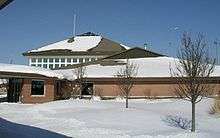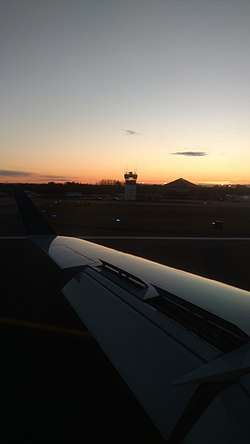Ithaca Tompkins Regional Airport
| Ithaca Tompkins Regional Airport | |||||||||||||||
|---|---|---|---|---|---|---|---|---|---|---|---|---|---|---|---|
.png) | |||||||||||||||
 | |||||||||||||||
| Summary | |||||||||||||||
| Airport type | Public | ||||||||||||||
| Owner | Tompkins County | ||||||||||||||
| Serves | Ithaca, New York | ||||||||||||||
| Location | Lansing, New York | ||||||||||||||
| Elevation AMSL | 1,099 ft / 335 m | ||||||||||||||
| Coordinates | 42°29′29″N 076°27′31″W / 42.49139°N 76.45861°WCoordinates: 42°29′29″N 076°27′31″W / 42.49139°N 76.45861°W | ||||||||||||||
| Website | www.FlyIthaca.com | ||||||||||||||
| Map | |||||||||||||||
 ITH Location in New York  ITH ITH (the US) | |||||||||||||||
| Runways | |||||||||||||||
| |||||||||||||||
| Statistics (06/2014 - 06/2015) | |||||||||||||||
| |||||||||||||||

Ithaca Tompkins Regional Airport (IATA: ITH[3], ICAO: KITH, FAA LID: ITH) is a county-owned airport three miles northeast of Ithaca, the county seat and only city in Tompkins County, New York.[1] The National Plan of Integrated Airport Systems for 2011–2015 categorized it as a primary commercial service facility.[4] Federal Aviation Administration records say the airport had 103,501 passenger boardings (enplanements) in 2013.[5]
History
The original Ithaca Municipal Airport was west of downtown Ithaca, near the inlet of Cayuga Lake. Its single short runway, proximity to the Lehigh Valley freight yards on the south side, the Cayuga Lake marshes on the north side, and fog in the lake valley limited its growth. Cornell University opened the existing airport on East Hill in 1948 and transferred its ownership to the County in 1956. The former airport site is now Cass Park, including a hangar which was renovated in 1975 to house the Hangar Theatre.[6]
The original airport was the base where aviation pioneer Cecil Robinson began flying aerial photography missions. In 1945, shortly after the end of World War II, he created Robinson Airlines, basing its maintenance operations at the airport. Scheduled DC-3 flights began in 1948; the airline changed its name to Mohawk Airlines in 1952 and merged with Allegheny Airlines in 1972. Later the airport was served by Empire Airlines and Air North; the latter became Brockway Air, which merged into Piedmont Airlines. Allegheny, Piedmont, and Empire all eventually merged into US Airways, which later merged into American Airlines.
Other carriers included Commuter Airlines, Mall Airways, Command Airways (later dba American Eagle), Ransome Airlines (also dba TW Express and United Express), and Continental Express.
In 1994, a new, 33,000 square foot (3,000 m²), $11-million terminal opened, replacing the cramped original building. Simultaneously, the runway was extended from 5,801 feet (1,768 m) to its present 6,977 feet (2,127 m). Runway 32 has an instrument landing system and a medium intensity approach light system with runway alignment lights. Runway 14 has an instrument approach based on the VOR/DME at the airport. A short turf runway was commissioned parallel to the paved runway, but during the 1980s a north-south turf runway was west of the terminal building, about 1,802 feet (549 m) long and 100 feet (30 m) wide.
Airline traffic peaked in 1990 at 226,813 passengers,[2] but by the end of the decade the small size of the market, proximity to Syracuse Hancock International Airport and other regional airports, and crowded airspace led Trans World Airlines, United Airlines, and finally Continental Airlines to leave.
In 2001, the airport adopted its current name, replacing its former moniker, the Tompkins County Airport.
In late 2004, after negotiations with the County, Northwest Airlines agreed to add Northwest Airlink service to Detroit Metropolitan Wayne County Airport, which began May 2, 2005. US Airways nonstops to Pittsburgh, a focus city, resumed on November 9, 2005 but ended on April 1, 2006 due to low yield. Passenger traffic has improved with the additional service; the airport served about 140,000 passengers in 2004, increasing to around 170,000 in 2007.[2] On October 6, 2008, Continental Connection resumed service between Ithaca and Newark Liberty International Airport with four daily flights. In 2011, the airport served 242,493 passengers on three airlines.

In 2009 Regional Elite Airline Services took over ground handling duties from Mesaba Airlines for the Delta Connection flights to Detroit. As of November 2012, all ground handling for Delta and United Airlines will be by DAL Global Services.
Starting on March 24, 2012, US Airways Express ended all service between Ithaca and New York–LaGuardia as part of a slot-exchange deal with Delta.[7]
The 2013 Federal sequester did not result in the closure of the airport's control tower. The U.S. Department of Transportation restored the funding needed to support the continued operation of the Ithaca air traffic control tower. [8][9][10]
In 2014, Robert Nichols, who had been the airport's general manager since 1990, retired.[11]
On September 12, 2017, the airport announced that it had been awarded $2.4 million in grants from the FAA to rehabilitate the general aviation tarmac, add new perimeter fencing and lighting, and build a second passenger boarding bridge.[12] Simultaneously, United Airlines announced that it was upgrading its Ithaca to Newark service from 37-seat Dash 8 turboprop aircraft to 50-seat, Embraer ERJ-145 jet aircraft, meaning that all flights to and from Ithaca will be aboard jet aircraft.[13]
On May 3, 2018, New York State Governor Andrew Cuomo announced at the airport a new $22 million project to double the size of the 25-year-old airport terminal, adding six new gates, three new jetbridges, and a customs facility to allow international air travel to Ithaca, as well as expanded office space for the Transportation Security Administration and airlines.[14]
On July 12, 2018, the airport announced that American Airlines would start direct service to Charlotte, with one weekly flight on Saturdays beginning in December 2018.[15]
Facilities
The airport covers 531 acres (215 ha) at an elevation of 1,099 feet (335 m). It has two runways: 14/32 is 6,977 by 150 feet (2,127 x 46 m) asphalt and 15/33 is 2,018 by 50 feet (615 x 15 m) turf.[1]
In 2011 the airport had 41,286 aircraft operations, average 113 per day: 77% general aviation, 23% air taxi, <1% military, and <1% airline. 57 aircraft were then based at the airport: 77% single-engine, 9% multi-engine, and 14% jet.[1]
For over 60 years, the airport has been home to the East Hill Flying Club. The club offers lessons and the use of nine small planes to its members.[16] It is also the home of Taughannock Aviation which provides business jet charter and management as well as being the fixed-base operator.[17]
Delta Connection uses the Bombardier CRJ200 to and from ITH. American Eagle and United Express use the Embraer EMB-145 to and from ITH.
Airlines and destinations
| Airlines | Destinations |
|---|---|
| American Eagle | Charlotte (begins December 22, 2018),[18] Philadelphia |
| Delta Connection | Detroit |
| United Express | Washington–Dulles[19] |
Traffic
| Rank | Airport | Passengers | Carriers |
|---|---|---|---|
| 1 | Philadelphia, Pennsylvania | 38,000 | American |
| 2 | Detroit, Michigan | 34,000 | Delta |
| 3 | Newark, New Jersey | 25,000 | United |
Ground transportation
Bus
TCAT Route 32 travels to Cornell University and downtown Ithaca (Ithaca Commons) Monday through Friday,[21] On weekends similar service is on Route 72.[22] Both routes operate hourly, or more frequently, throughout most of the day.
Taxi
Ithaca Dispatch (Cayuga, University, Yellow Cab) operates a taxi stand at the airport, although it may be necessary to call in advance, especially during peak hours. Fares to the airport are standardized.
References
- 1 2 3 4 FAA Airport Master Record for ITH (Form 5010 PDF). Federal Aviation Administration. Effective November 15, 2012.
- 1 2 3 "Ithaca Tompkins Regional Airport". official website.
- ↑ "IATA Airport Code Search (ITH: Ithaca / Tompkins County)". International Air Transport Association. Retrieved July 13, 2013.
- ↑
"2011–2015 NPIAS Report, Appendix A" (PDF). National Plan of Integrated Airport Systems. Federal Aviation Administration. October 4, 2010. Archived from the original (PDF, 2.03 MB) on September 27, 2012. External link in
|work=(help) - ↑ "Passenger Boarding (Enplanement) Data for CY 2013 (final)". Federal Aviation Administration. September 2014.
- ↑ Hangar Theatre
- ↑ Milian, Kevin (February 13, 2012), "After Deal, U.S. Airways Cancels Ithaca Flights to LaGuardia", Cornell Daily Sun, archived from the original on May 24, 2012
- ↑ "FAA Contract Tower Closure List". American Association of Airport Executives. March 22, 2013.
- ↑ "FAA: 149 control towers to close at small airports". USA Today. March 22, 2013.
- ↑ "Ithaca Airport Tower to Remain Open". Tompkins County Government. May 10, 2013.
- ↑ "Ithaca Tompkins Regional Airport Manager Robert Nicholas to Retire". Ithaca Tompkins Regional Aorport. 2014-04-16.
- ↑ Mearhoff, Sarah (2017-09-12), "Ithaca Tompkins Regional Airport awarded more than $2 million in federal grants", Ithaca Journal
- ↑ "Upgrade: United Airlines bringing jet service to Ithaca, Tompkins airport", Ithaca Voice, 2017-09-12
- ↑ "'Truly transformative' projects will overhaul airport, open up valuable waterfront space", Ithaca Voice, 2018-05-03
- ↑ "American Airlines to offer new flights from Ithaca to Charlotte", Ithaca Voice, 2018-07-18
- ↑ East Hill Flying Club
- ↑ Taughannock Aviation
- ↑ https://ithacavoice.com/2018/07/american-airlines-offer-new-flights-ithaca-charlotte/
- ↑ "United adjusts Newark domestic network from Oct 2018". Retrieved 13 May 2018.
- ↑ "Ithaca/Cortland, NY: Ithaca Tompkins Regional (ITH)". Bureau of Transportation Statistics. November 2016.
- ↑ TCAT route 32
- ↑ TCAT route 72
External links
- Ithaca Tompkins Regional Airport
- Ithaca Tompkins Regional (ITH) at New York State DOT Airport Directory
- Aerial image as of March 1995 from USGS The National Map
- FAA Airport Diagram (PDF), effective October 11, 2018
- FAA Terminal Procedures for ITH, effective October 11, 2018
- Resources for this airport:
- AirNav airport information for KITH
- ASN accident history for ITH
- FlightAware airport information and live flight tracker
- NOAA/NWS latest weather observations
- SkyVector aeronautical chart for KITH
- FAA current ITH delay information